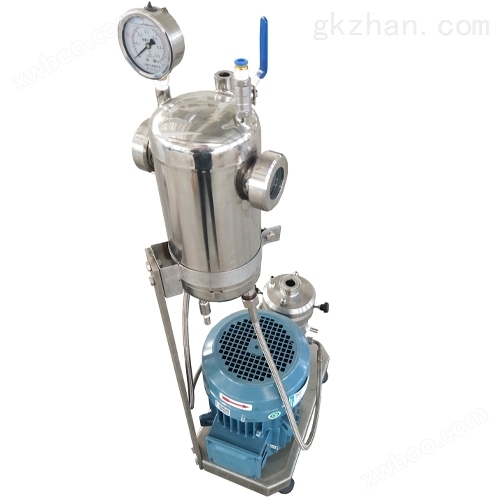Plastic additive high shear grinding and dispersing machine
Plastic additive colloid mill, plasticizer grinding and dispersing machine, heat stabilizerDisperser, light stabilizer disperser, laboratory disperser
A large class of additives used in plastic molding and processing products, including plasticizers, heat stabilizers, antioxidants, light stabilizers, flame retardants, foaming agents, anti-static agents, mold inhibitors, coloring agents, and whitening agents (seePigment)Fillers, coupling agents, lubricants, release agents, etc. Among them, coloring agents, whitening agents, and fillers are not plastic specific chemicals, but commonly used compound materials.
Plastic additives are used inpolyvinyl chlorideIt gradually developed after industrialization. After the 1960s, due to the rise of petrochemicals,Plastic industryRapid development has made plastic additives an important chemical industry. According to the differences in the composition of plastic varieties and plastic uses in different countries, the consumption of plastic additives is about 8% to 10% of plastic production. At present, plasticizers, flame retardants, and fillers are the most commonly used plastic additives.
Plasticizers are a type of low volatility organic compound that can be mixed with polymers to a certain extent. They can reduce the viscosity of polymer melts, as well as the glass transition temperature and elastic modulus of the products. Its mechanism of action is based on the weakening of the intermolecular attraction of polymer molecules by plasticizer molecules.
Plasticizers are the earliest used plastic additives. In the second half of the 19th century, camphor andPhthalate estersAs a plasticizer for nitrocellulose. After the industrialization of polyvinyl chloride in 1935, plasticizers were widely used. Currently, about 80% is used for polyvinyl chloride and vinyl chloride copolymers, while the rest is used for cellulose derivatives, polyvinyl acetate, polyvinyl alcohol, natural and synthetic rubber. On average, 45% to 50% (by mass, the same applies below) plasticizer is added to soft polyvinyl chloride. Due to the rapid development of rigid polyvinyl chloride without or with minimal addition of plasticizers, the growth rate of plasticizers in many industrialized countries has been lower than that of polyvinyl chloride. China's PVC soft products still account for a large proportion, so plasticizers will continue to have rapid development.
Phthalates are the main body of plasticizers, accounting for about 80% of the total plasticizer production. Among them, dioctyl phthalate (DOP) is the most important variety. Plasticizers with smaller production scales include:adipic acidEsters of sebacic acid (with good cold resistance), phosphate esters (with flame retardant effect), epoxy oil and epoxy esters (with synergistic effect with heat stabilizers), trimellitic acid esters, esters (with good heat resistance), chlorinated paraffin wax (auxiliary plasticizer and flame retardant plasticizer), alkyl sulfonic acid phenyl ester (auxiliary plasticizer).
Light stabilizer plastics and other polymers absorb ultraviolet energy, which can trigger auto oxidation reactions and lead to degradation. This process is called photooxidation or photoaging, and substances that can inhibit or delay this process are called light stabilizers. In the 1940s, * firstCellulose acetateUse phenyl salicylate as a light stabilizer. In the early 1950s and early 1960s, benzophenones and benzotriazoles appeared respectively, and in the mid-1970s, hindered amine light stabilizers emerged. Light stabilizers are mainly used for polyolefins, especially polypropylene. Polyvinyl chloride, polycarbonate, and polyester also use a small amount of light stabilizer, with a dosage of about 0.1% to 0.5%.
Grinding and dispersing machine is a high-tech product composed of colloid grinding and dispersing machines.
The first level consists of three-level sawtooth protrusions and grooves with increasing precision. The stator can be infinitely adjusted to the desired distance between the rotors. Under enhanced fluid turbulence. The groove can change direction at each level.
The second stage is composed of a stator. The design of the dispersing head also effectively meets the needs of substances with different viscosities and particle sizes. The difference in the design of the stator and rotor (emulsifying head) between online and batch machines is mainly due to the requirements for conveying performance. It is particularly important to note that the difference between coarse precision, medium precision, fine precision, and other types of working heads is not only the arrangement of specified rotor teeth, but also an important difference in the geometric characteristics of different working heads. The width of the slot and other geometric features can alter the different functions of the stator and rotor working heads.
The following is a model table for reference:
model |
Standard flow rate L/H |
Output speed rpm |
Standard linear velocity m/s |
Motor power KW |
Imported size |
Export size |
XMD2000/4 |
400 |
18000 |
44 |
4 |
DN25 |
DN15 |
XMD2000/5 |
1500 |
10500 |
44 |
11 |
DN40 |
DN32 |
XMD2000/10 |
4000 |
7200 |
44 |
22 |
DN80 |
DN65 |
XMD2000/20 |
10000 |
4900 |
44 |
45 |
DN80 |
DN65 |
XMD2000/30 |
20000 |
2850 |
44 |
90 |
DN150 |
DN125 |
XMD2000/50 |
60000 |
1100 |
44 |
160 |
DN200 |
DN150 |
Plastic additive high shear grinding and dispersing machine

